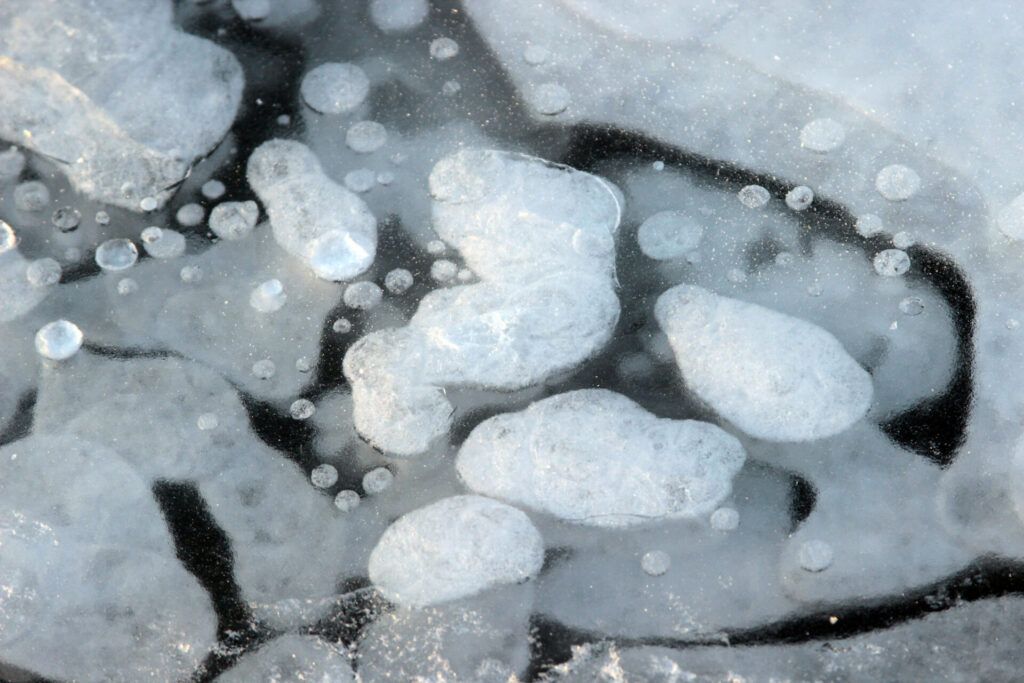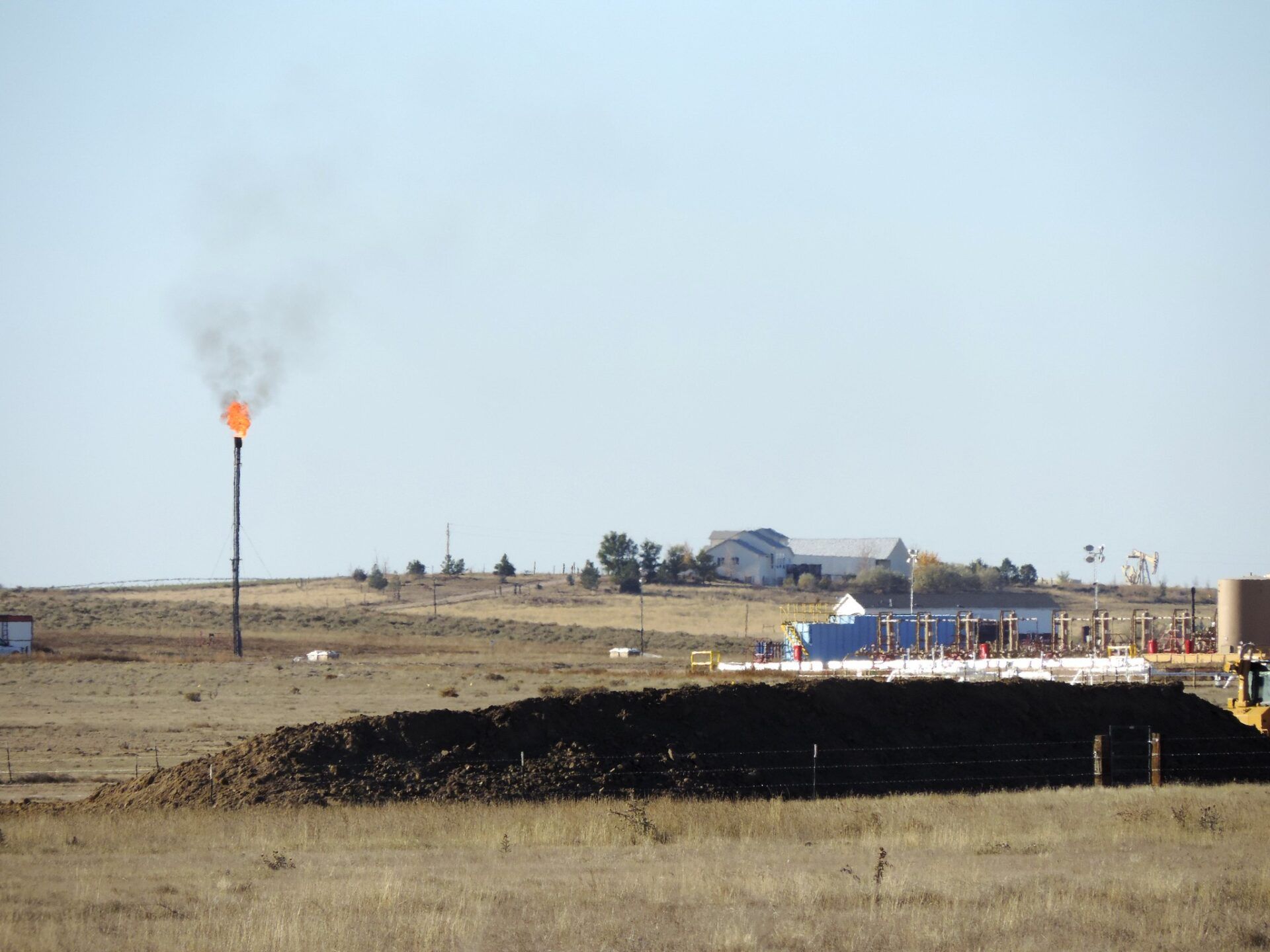‘Mass delusion and wishful thinking’: Why everything you think you know about methane is probably wrong
By Jessica McKenzie | December 18, 2023
 Methane gas bubbles are seen trapped in the ice of a frozen thermokarst lake. This gas is released into the Arctic atmosphere from both the frozen layer and the underlying waters during the spring thaw. Only 60 percent of methane emissions are from human activity, and as the world gets warmer and wetter, you can get more methane emissions from natural sources. (Kevin Hand, NASA Jet Propulsion Laboratory)
Methane gas bubbles are seen trapped in the ice of a frozen thermokarst lake. This gas is released into the Arctic atmosphere from both the frozen layer and the underlying waters during the spring thaw. Only 60 percent of methane emissions are from human activity, and as the world gets warmer and wetter, you can get more methane emissions from natural sources. (Kevin Hand, NASA Jet Propulsion Laboratory)
Have you heard about the miracle quick-fix for our climate ills?
The greenhouse gas methane is responsible for roughly 30 percent of the increase in global temperature since the industrial revolution and is often described as 80 times more potent than carbon dioxide. Sometimes news outlets remember to qualify that with “over 20 years,” and sometimes they don’t.
In a press call during the 28th Conference of Parties, the annual United Nations climate conference, US Sen. Sheldon Whitehouse of Rhode Island said methane was his “number one” priority at the conference. Shortly after, the Biden administration announced a new EPA rule targeting methane emissions. The press release announcing the rule stated, “Sharp cuts in methane emissions are among the most critical actions the United States can take in the short term to slow the rate of climate change.”
“[T]he U.S. is turbocharging the speed and scale of climate action, at home and abroad, including our collective efforts to tackle super-pollutants like methane,” said US National Climate Advisor Ali Zaidi.
The popular narrative suggests that tackling methane emissions is the “low-hanging fruit” in the climate-solutions toolbox. The belief that turning off the taps on this “super-pollutant” could “buy us time” to address the climate crisis is widespread, shared by politicians, journalists, and even some scientists.
But this is a dangerous fallacy, according to Raymond Pierrehumbert, a professor of physics at the University of Oxford and a member of the Bulletin of the Atomic Scientists Science and Security Board.
In an in-depth interview with Bulletin climate editor Jessica McKenzie, Pierrehumbert dissects the Oil and Gas Decarbonization Charter—the voluntary pledge made at COP28 by some oil and gas companies to slash operational emissions of greenhouse gases, including bringing methane emissions to “near-zero.” He goes on to explain why describing methane as “80 times as potent as carbon dioxide” is inaccurate and misleading and why the widespread hope that sharp cuts to methane emissions will bring about immediate and significant reductions of global temperatures is both wrong and distressing.
Editor’s note: This interview has been condensed and edited for brevity and clarity.
Jessica McKenzie: I was wondering if we could start just by talking about the Oil and Gas Decarbonization Charter and what it is and what it isn’t.
Raymond Pierrehumbert: Altogether this Oil and Gas Decarbonization Charter is very small potatoes. It refers only to decarbonization of the operations of the oil companies, which means that they’re not counting the much bigger carbon dioxide emissions from the burning of their product, just the operation, which is really a small part of the of the total, especially in the Middle Eastern countries where the cost of oil production is actually very low compared to the US and not very energy intensive to begin with. It’s less energy intensive than fracking; you don’t have to redrill the wells as often. But no matter what the country, the carbon emissions from operations is a small part of the total compared to actually burning the fossil fuels.
A second part is putting money into carbon dioxide removal, Carbon Dioxide Capture and Storage. Just about everybody agrees we’ll need a certain amount of that, once we’ve gotten carbon dioxide emissions down to nearly zero, but right now, as Pierre Friedlingstein has said recently, the existing air capture projects are capturing one-one-millionth of what they would need to, and even under outrageously optimistic projections, where they improve by a factor of 1,000, or even 10,000, that’s still not going to do the job of decarbonization.
The role of carbon dioxide air capture, or capture and sequestration, is in dealing with the last 10 percent or so of emissions that we can’t easily avoid. That would include things like hard-to-decarbonize sectors, maybe aircraft, it would include include rogue nations; you know, North Korea isn’t likely to sign on to emission reductions. Whether you call it a phase-down or a phase-out, the fact is that we have to get emissions down by about 90 percent before we can even think about a possible role of air capture in sopping up the rest. So while it is useful to have another entity putting money in to develop the technology, because we will need some of it, it’s not the game changer. It only becomes an important part of the strategy once we get down to within shouting distance of net zero.
And it should also be noted that a lot of the existing air capture and what is being talked about actually uses this captured carbon dioxide to produce more oil. They call that low carbon fuel, but it’s a kind of a dodge, because right now, oil companies are already using carbon dioxide injection that they buy commercially to produce oil. And if you just switch that commercially purchased carbon dioxide from say, leftovers from the Haber process [the process used to produce ammonia, of which carbon dioxide is a by-product], and switch that for air capture, it’s just a wash, it doesn’t actually change anything. Except that they [the fossil fuel companies] get to look greener.
If companies can reduce their operational emissions, that’s a good thing. It’s just that’s such a small part of the total. It’s not a game changer. These are baby steps. And we’re at a time in the climate crisis when baby steps are not going to cut it.
Now as far as methane goes—that’s where we get into the subtler issue of just what is carbon dioxide equivalent, or just all the fallacies associated with the term carbon dioxide equivalent, because the standard way that companies claim credit for their methane emissions reductions is to use a carbon dioxide equivalent number. And what’s come into favor is this figure based on 20 years, which is what gets you methane is 80 times [as potent as carbon dioxide].
McKenzie: Could you explain a little bit more about where that comparison came from and why that is a flawed descriptor?
Pierrehumbert: The 80 times figure comes from the standard Global Warming Potential framework, which was introduced in the very first IPCC (Intergovernmental Panel on Climate Change) report, but what everybody forgot was that it was introduced as an example of how to do a comparison, and not as something people should actually use to make decisions. Nonetheless it stuck.
The main thing is that there is no true equivalence between carbon dioxide emissions and methane emissions, because the climate responds in different ways to a short-lived gas than to a long-lived gas. If you put a kilogram of carbon dioxide in the atmosphere it has a warming effect that lasts millennia. You put a kilogram of methane in the atmosphere, the warming effect will disappear almost entirely after 20 years. So the amount of warming you get depends on the emission rate of methane, not the amount of emissions you put in the atmosphere. A kilogram per year gives you a certain amount of warming, because it doesn’t accumulate in the atmosphere beyond about 20 years. Whereas a kilogram per year of carbon dioxide will mount up to a certain amount of warming in the first 20 years. But if you keep emitting that kilogram per year, the amount of warming you get continues to increase indefinitely, which does not happen with methane. So any equivalence that says that a certain mass of methane is equivalent to this other mass of carbon dioxide, one megaton of methane is worth a certain number of megatons of carbon dioxide, anything like that is going to distort the climate response.
There is a way to compare them, which is to compare the actual amount of warming produced by different strategies.
McKenzie: That’s not what the 80 times of warming comparison does?
Pierrehumbert: No, it’s not really what the 80 times does. Or it does it in a very flawed way that only looks at what happens in the first 20 years and doesn’t look at the way carbon dioxide outstrips the effect of methane, eventually. Also, these equivalences compare the wrong quantities. The thing that’s wrong about these equivalences is that the methane warming is determined by a rate—megatons per year—where the carbon dioxide warming is determined by a number of megatons of cumulative emissions over any period of time. So it literally is comparing apples and oranges, because to do an actual equivalence between carbon dioxide and methane requires something that compares a rate to a mass.
It’s like comparing a distance traveled to the speed at which your car is going. These are two different things. Carbon dioxide is like the total distance your car has gone, so it’s the cumulative progress towards your destination, and our destination, in this case is making the world too hot to be livable. Whereas methane is just like the speed at which the car is going. That’s not a good analogy, really—it’s a fair analogy mathematically, but in terms of people getting their heads around it, it’s maybe not so good.
But the basic thing is that the standard 80 times figure, which is used in many attempts to say what the value is of methane and in avoided warming—that 80 times figure does not take into account the fact that after about 20 years, methane essentially stops causing further warming.
McKenzie: Well, humans are flawed animals who think in very short timescales, so it is kind of understandable how sharp methane reductions would appeal to us in a sort of get-rich-quick scheme. And why we think we can you know, halt global warming in its tracks if we cut all this off.
Pierrehumbert: Yeah, it’s a cognitive flaw. It’s what is called a stock versus flow problem. So methane is a flow pollutant; it doesn’t accumulate in the atmosphere. Carbon dioxide is a stock pollutant—the harm is determined by the cumulative stock of it in the atmosphere. And people are seduced by this 80 times worse over 20 years, because they think, you know, 20 years, that’s the time scale we have to do something about. But what they’re failing to understand—and even the economists fell in this trap—is that over that first 20 years, there’s very little warming involved. So the total amount of warming that you can avoid by huge reductions in methane, it’s a significant number. But it’s not significant compared to how much warming we’re going to get in 100 years, if we don’t decarbonize.
And what’s more, if you happen to delay your action on methane, since the methane effect disappears in about 20 years, there’s relatively little harm in delaying, because it’s still valuable [when it happens]. But if you delay action on carbon dioxide, the carbon dioxide keeps accumulating in the atmosphere, and it never goes away. So decarbonization, actual carbon dioxide reductions, are the biggest priority.
Maybe the easiest way of looking at the reason that methane has significant but very limited leverage over future warming is to just look at the maximum amount of warming you could eliminate.
It’s estimated that the methane increase since the industrial revolution has accounted for between 25 to 30 percent of warming. We have about 1.3 degrees Celsius of warming, maybe it’s 1.4 degrees Celsius, depending on exactly how you do the computation. So 30 percent of that is .4 degrees. If you could eliminate half of the methane emissions—which would be pretty ambitious—but if you can eliminate half of the methane emissions, you could shave two-tenths of a degree.
But if we don’t get to net zero carbon dioxide emissions, under current trajectories, we’re heading for a whole degree of warming in the next century. I think it’s actually pretty optimistic to get the methane warming down by .2 degrees, because you have to recognize that not all of that methane increase since the beginning of the industrial revolution is due to human activities. NASA thinks it’s only about 60 percent.
McKenzie: So the rest is from peat bogs, melting permafrost, cows—or would cows count as human activity?
Pierrehumbert: Cows count as human activity. The increase in livestock due to agriculture, that counts as human activity. But that other 40 percent of emissions that NASA talks about, some of that was baseline emissions. But some of that is due to feedbacks in natural systems. So as the world gets warmer and wetter, you can get more methane emissions from natural sources. And that’s a feedback that we can only control by controlling our warming.
So this is not to say that eliminating methane emissions is bad, because it does help. But what’s really damaging is fooling yourself into thinking that eliminating methane has as big an impact as eliminating carbon dioxide.
This becomes materially bad if you have a trading scheme that actually allows a company to trade carbon dioxide for methane on this 80 times figure, because then that winds up being a nightmare scenario, where some company will abate a certain amount of methane and then claim huge credits.
It’s good to reduce methane. But we shouldn’t exaggerate how big a part of the problem this is. Because if you use this 80 times figure, it completely exaggerates the amount of avoided warming that’s possible with even the most aggressive action on methane.
The second part of the message is yes, there’s no real reason for oil companies to let all that methane into the atmosphere, they should capture it and use it. But that needs to be handled in a way that doesn’t allow trading of methane abatement against carbon dioxide (emissions).
McKenzie: It’s important to reiterate that this decarbonization charter we’ve been talking about is a voluntary measure.
Pierrehumbert: Exactly. And it involves companies, not countries. So 50 companies, representing 40 percent of global oil production, have signed on. And it’s a pledge, right? Nothing happens to them, if they don’t do this.
McKenzie: And there are so many alarming phrases that stuck out to me, like eliminating routine flaring, means that they can keep flaring for non-routine reasons. And it seems like there’s a lot of potential there for that to be incredibly broad.

Pierrehumbert: Yes. In fact, already, The Guardian has reported that state-run companies in the Emirates are cheating on their commitments they’ve made already, where satellite monitoring suggests there’s a lot more flaring (of methane) than they say. So yeah, there are all sorts of ways this methane charter could be dodged, but my main message is, even if we take it at face value, and even if they do everything they say, this is not a major step forward.
McKenzie: The other sort of thing where I felt that they were already building in excuses for not doing things was this caveat about adjusting ambitions for companies and countries, depending on their circumstances. That also sounds like a loophole.
Pierrehumbert: That’s all very true; they’re giving themselves a lot of ways out. And this point about energy security and affordability—the fossil fuel industry is always saying we have to provide cheap fossil fuel energy in the developing world. But there’s a good argument that actually the developing world would do better if they had money to accelerate the transition to renewables, which would make them independent of the fossil fuel hostage situation that they’ve got now.
McKenzie: I sat in on a press call with some of the congressional representatives who have gone to COP, and Sheldon Whitehouse said his number one priority was methane. What’s your message for the politicians who have taken methane as their guiding star, and the journalists who are supporting this narrative, that methane is the big thing that we should be focusing on?
Pierrehumbert: It’s a mass delusion and wishful thinking, based on a fundamental failure to understand the different ways that a short-lived gas like methane affects the climate versus a long-lived gas like carbon dioxide. The basis of the fallacy is the total amount of warming you can avoid by any likely amount of methane reduction is small, compared to what needs to be done. And it just comes from a fundamental lack of understanding of basic climate physics.
It is useful to reduce methane, but it’s not going to really help us towards net zero. The only real solution to the climate crisis is to get carbon dioxide emissions down to as close to zero as we can.
This fallacy about methane being the big priority, it’s something that is not just created by journalists and politicians. There are a lot of scientists, who—for reasons that are very perplexing to me—have been pushing the idea of methane very, very aggressively, like the Climate and Clean Air Coalition. Politicians like it because it sounds less disruptive. And a lot of politicians have fallen for the false notion that we can have a big impact on warming by reducing methane emissions. But what they just don’t see is the amount of warming you actually avoid by doing this is actually pretty small in the big scheme of things.
They can easily be seduced by statistics like methane is responsible for 30 percent of the warming now, which implies that we can get rid of that much warming by aggressively acting on methane. But that ignores how much methane is due to natural sources we can’t control.
It is a mass delusion. Even the IPCC has been very resistant to moving away from this false global warming potential equivalence, which goes back to the very first IPCC report. Myles Allen and I have been fighting this fight with IPCC. Myles is my colleague at Oxford and goes to COP meetings, and he couldn’t even get our improved ways of putting methane valuation on the agenda or mentioned in the reports. The IPCC is a very conservative organization, and because they—and policymakers—have gotten so used to these global warming equivalents, they seem very reluctant to change. It’s very distressing. And reporters have just been completely taken in by the notion that methane is the important thing.
McKenzie: I feel like it’s quite easy to do, given that the figures that are bandied about, as you said, by scientists, sound very convincing. It’s a compelling narrative that methane has going.
Pierrehumbert: Part of it is people don’t realize how much warming we’re in for due to carbon dioxide if we continue emitting the way we’ve been doing. The amount of warming we can plausibly avoid, by even very aggressive action on methane, is a useful contribution, but it’s a drop in the bucket compared to how much warming we’re going to be saddled with if we don’t get carbon dioxide emissions down to net zero.
It’s difficult messaging, in the sense that I don’t want to say that controlling methane emissions is unimportant, especially some of the projections of how much methane emissions might increase if the whole world starts eating beef at the rate that America does—those are big numbers. They’re not as big numbers as carbon dioxide, but they’re significant. Although it’s important, it doesn’t really help you buy time to get the carbon dioxide down, because any carbon dioxide you emit is stuck in the atmosphere for thousands of years. Much of it anyway—enough of it to cause severe warming. So there are all sorts of cognitive and messaging problems associated with methane. And I’ve been trying to figure out how to get these things across.
I’ve written to Guardian reporters over and over again, and they say, “oh, yeah, well, that sounds plausible,” but then I look at the paper the next day and there’s some other reporter pushing the exact same methane messaging, it’s like Whack a Mole. But when even The Economist, which is usually very careful, has cottoned on to this 80-times-worse figure, that’s really seriously distressing.
McKenzie: It’s worth mentioning that UN Secretary-General António Guterres put out a statement that said the pledges by oil companies were insufficient. He didn’t specifically call them out for greenwashing, but he said we must avoid greenwashing, and that the focus should be reducing fossil fuels.
Pierrehumbert: That is good. I’m glad someone picked up on that. And one thing I forgot to say is that a lot of these methane emissions reductions that are being promised would happen automatically if they just stopped producing fossil fuels. The argument for a separate, targeted methane reduction program in the oil industry is just an end run, when what we need is accelerated reduction in fossil fuel production. And that would take care of it.
Together, we make the world safer.
The Bulletin elevates expert voices above the noise. But as an independent nonprofit organization, our operations depend on the support of readers like you. Help us continue to deliver quality journalism that holds leaders accountable. Your support of our work at any level is important. In return, we promise our coverage will be understandable, influential, vigilant, solution-oriented, and fair-minded. Together we can make a difference.
















Hi Raymond and Jessica, Thanks for this column and your interesting analysis. I’;d be curious if you could add in your analysis how methane concentrations over time accumulate despite its short half-life. That is, while methane this year will be degraded in 20 years, the methane output continues (increases?) year after year. So a steady state equilibrium of the concentration will be established and, as methane emissions increase over time, so would the steady state levels. How does “equilibrium” or to what level of warming does this equilibrium contribute to warming (or is that inherent in the “25 to 30… Read more »
It doesn’t put into consideration that the Methane release out of the ground, especially in the Arctic is caused by global warming = the burning of fossil fuels.
Pierrehumbert: Cows count as human activity. The increase in livestock due to agriculture, that counts as human activity. But that other 40 percent of emissions that NASA talks about, some of that was baseline emissions. But some of that is due to feedbacks in natural systems. So as the world gets warmer and wetter, you can get more methane emissions from natural sources. And that’s a feedback that we can only control by controlling our warming.
Thanks Werner. Your point is well stated and interacts with many of the ones outlined below (particularly living Canada where the massive burning of forests and the impending “methane bomb” of the vast permafrost areas are important). As all of these comments seem to indicate, the idea that somehow LNG is even a short term strategy reduce GHG-dependent warming seems a vacuous argument.
I see the point about the warming effect of methane disappearing after 20 years, but in order not to exceed the target of 1.5 °C surely it makes sense to aim for the two tenths of a degree reduction professor Pierrehumbert suggests we could achieve by eliminating half of methane emissions. The reason it is considered the “low hanging fruit” of climate mitigation is that fugitive methane emissions benefit no-one, are relatively easy to prevent, and doing so saves money.
Just to say that what haunts my bad dreams are the numbers from permafrost methane, and what the C12/C13 ratios suggested by way of methane degassing across the Permo-Triassic boundary. (There was a pulse of isotopically light carbon, suggesting exponential feedback involving CH4). It is reassuring that one can expect a molecule of methane to be oxidised after 20 years, but if by then it has led to the degassing of more methane then you can still get a feedback loop. The P/T boundary was associated with high temperatures, low oxygen concentrations, and took about 1 million years to settle… Read more »
I have to agree with you. The permafrost methane is the issue that haunts me too. As Professor Pierrehumbert says the rate is crucial to the effect and I fear that the rate of methane release from the permafrost due to a positive feedback loop could reach a point where the accumulation could do enough damage to change things permanently on the planet well within this century. It is not a very well quantified subject. Figures for the exact amount of methane coming out of this area are hard to obtain. But the rate of thaw has been massive since… Read more »
I disagree with Dr. Pierrehumbert’s view. The point is to try to reduce harmful impacts to the environment in the most cost effective way when weighted by some agreeable average of time preferences that in particular don’t discount the distant future or the present to near zero. Methane has multiplier effects on CO2 emission (e.g. wildfires, etc.) and CO2 has multiplier effects on methane (e.g. peat bogs, etc.). CO2 has other impacts besides just warming (e.g. ocean acidification, etc.) All of this needs to be taken into account and the complexity of it all makes a mockery of Dr. Pierrehumbert’s… Read more »
So the claim is that methane isn’t so bad because of its short life time. But I remind you that the “death” of methane is the production of carbon dioxide. If I read this fact correctly, methane is only BRIEFlY terrible but long term, bad.
The analysis overlooks the effects of animal agriculture replacing land that had crbon-sequestering trees to land with methane-belching cows and the possibility of reforesting which would reduce the present very dangerous level of atmosphere CO2 to a much safereafer one.
I don’t fully understand Prof. Pierrehumbert’s argument. Yes, CH4 has a GWP of 80 over 20 years, but it also has a GWP of almost 30 over a 100 year period. It doesn’t just disappear after 20 years in the atmosphere. It reacts with O2 to form an even greater mass of CO2 (compared to the mass of the methane) and water, both of which are GHGs. So in that sense putting methane into the atmosphere lasts as long and CO2 does because methane decomposes into CO2 (and water).
So methane should be regarded as a rate, due to its short half life? This means that long slow CH4 emissions are effectively just CO2, even if the carbon got there by an indirect route. But has anyone modelled the boundaries that define a methane pulse? The hypothetical condition where a rapid increase in heating produces a rapid increase in biogenic methane emissions .. producing a pulse of heat that drives off more methane faster than the oxidation mechanisms can cope? There will be some combination of parameters here that could go exponential for a short period, but I do… Read more »